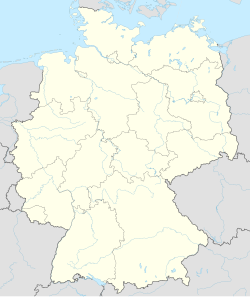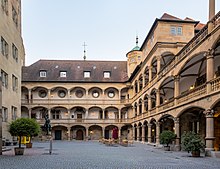my comment:
landed in Stuttgart after midnight and made my way to the university area ... loud disco music playing and open Coffee shops and restraunts and lots of glamour .... infact i was surprised the next day to find Milaneo where the Town hall library is situated .... in Mailander Platz !
Stuttgart
Jump to navigation
Jump to search
Stuttgart
| |
|---|---|

Clockwise from top left: Staatstheater, Cannstatter Volksfest in Bad Cannstatt, fountain at Schlossplatz, Fruchtkasten façade and the statue of Friedrich Schiller at Schillerplatz, New Palace, and Old Castle at Schillerplatz
| |
Location within Baden-Württemberg
| |
| Coordinates: 48°47′N 9°11′ECoordinates: 48°47′N 9°11′E | |
| Country | Germany |
|---|---|
| State | Baden-Württemberg |
| Admin. region | Stuttgart |
| District | Stadtkreis |
| Founded | 10th century |
| Subdivisions | 23 districts |
| Government | |
| • Lord Mayor | Fritz Kuhn (Greens) |
| Area | |
| • City | 207.36 km2 (80.06 sq mi) |
| Elevation | 245 m (804 ft) |
| Population
(2017-12-31)[3]
| |
| • City | 632,743 |
| • Density | 3,100/km2 (7,900/sq mi) |
| • Urban | 2,735,425 (31 Dec 2015)[2] |
| • Metro | 5,200,000 (2013)[1] |
| Time zone | CET/CEST (UTC+1/+2) |
| Postal codes |
70173–70619
|
| Dialling codes | 0711 |
| Vehicle registration | S |
| Website | www |
Schlossplatz, morning
Courtyard of the Old Castle
Stuttgart's hilly cityscape from atop the Karlshöhe
Since the 6th millennium BC, the Stuttgart area has been an important agricultural area and has been host to a number of cultures seeking to utilize the rich soil of the Neckar valley. The Roman Empire conquered the area in 83 AD and built a massive castrum near Bad Cannstatt, making it the most important regional centre for several centuries. Stuttgart's roots were truly laid in the 10th century with its founding by Liudolf, Duke of Swabia, as a stud farm for his warhorses. Initially overshadowed by nearby Cannstatt, the town grew steadily and was granted a charter in 1320. The fortunes of Stuttgart turned with those of the House of Württemberg, and they made it the capital of their county, duchy, and kingdom from the 15th century to 1918. Stuttgart prospered despite setbacks in the Thirty Years' War and devastating air raids by the Allies on the city and its automobile production during World War II. However, by 1952, the city had bounced back and it became the major economic, industrial, tourism and publishing centre it is today.[14]
Stuttgart is also a transport junction, and possesses the sixth-largest airport in Germany. Several major companies are headquartered in Stuttgart, including Porsche,[15] Bosch,[16] Mercedes-Benz,[17] Daimler AG,[18] and Dinkelacker.[19]
Stuttgart is unusual in the scheme of German cities.[20] It is spread across a variety of hills (some of them covered in vineyards),[21] valleys (especially around the Neckar river and the Stuttgart basin) and parks. This often surprises visitors who associate the city with its reputation as the "cradle of the automobile".[22][23] The city's tourism slogan is "Stuttgart offers more".[24] Under current plans to improve transport links to the international infrastructure (as part of the Stuttgart 21 project), the city unveiled a new logo and slogan in March 2008 describing itself as "Das neue Herz Europas" ("The new Heart of Europe").[25] For business, it describes itself as "Where business meets the future". In July 2010, Stuttgart unveiled a new city logo, designed to entice more business people to stay in the city and enjoy breaks in the area.[26]
Stuttgart is a city with a high number of immigrants. According to Dorling Kindersley's Eyewitness Travel Guide to Germany, "In the city of Stuttgart, every third inhabitant is a foreigner."[27] 40% of Stuttgart's residents, and 64% of the population below the age of five, are of immigrant background.[28]
my experience of
Jump to navigation
Jump to search
Stuttgart
| |
|---|---|

Clockwise from top left: Staatstheater, Cannstatter Volksfest in Bad Cannstatt, fountain at Schlossplatz, Fruchtkasten façade and the statue of Friedrich Schiller at Schillerplatz, New Palace, and Old Castle at Schillerplatz
| |
Location within Baden-Württemberg
| |
| Coordinates: 48°47′N 9°11′ECoordinates: 48°47′N 9°11′E | |
| Country | Germany |
|---|---|
| State | Baden-Württemberg |
| Admin. region | Stuttgart |
| District | Stadtkreis |
| Founded | 10th century |
| Subdivisions | 23 districts |
| Government | |
| • Lord Mayor | Fritz Kuhn (Greens) |
| Area | |
| • City | 207.36 km2 (80.06 sq mi) |
| Elevation | 245 m (804 ft) |
| Population
(2017-12-31)[3]
| |
| • City | 632,743 |
| • Density | 3,100/km2 (7,900/sq mi) |
| • Urban | 2,735,425 (31 Dec 2015)[2] |
| • Metro | 5,200,000 (2013)[1] |
| Time zone | CET/CEST (UTC+1/+2) |
| Postal codes |
70173–70619
|
| Dialling codes | 0711 |
| Vehicle registration | S |
| Website | www |
Schlossplatz, morning
Courtyard of the Old Castle
Stuttgart's hilly cityscape from atop the Karlshöhe
Since the 6th millennium BC, the Stuttgart area has been an important agricultural area and has been host to a number of cultures seeking to utilize the rich soil of the Neckar valley. The Roman Empire conquered the area in 83 AD and built a massive castrum near Bad Cannstatt, making it the most important regional centre for several centuries. Stuttgart's roots were truly laid in the 10th century with its founding by Liudolf, Duke of Swabia, as a stud farm for his warhorses. Initially overshadowed by nearby Cannstatt, the town grew steadily and was granted a charter in 1320. The fortunes of Stuttgart turned with those of the House of Württemberg, and they made it the capital of their county, duchy, and kingdom from the 15th century to 1918. Stuttgart prospered despite setbacks in the Thirty Years' War and devastating air raids by the Allies on the city and its automobile production during World War II. However, by 1952, the city had bounced back and it became the major economic, industrial, tourism and publishing centre it is today.[14]
Stuttgart is also a transport junction, and possesses the sixth-largest airport in Germany. Several major companies are headquartered in Stuttgart, including Porsche,[15] Bosch,[16] Mercedes-Benz,[17] Daimler AG,[18] and Dinkelacker.[19]
Stuttgart is unusual in the scheme of German cities.[20] It is spread across a variety of hills (some of them covered in vineyards),[21] valleys (especially around the Neckar river and the Stuttgart basin) and parks. This often surprises visitors who associate the city with its reputation as the "cradle of the automobile".[22][23] The city's tourism slogan is "Stuttgart offers more".[24] Under current plans to improve transport links to the international infrastructure (as part of the Stuttgart 21 project), the city unveiled a new logo and slogan in March 2008 describing itself as "Das neue Herz Europas" ("The new Heart of Europe").[25] For business, it describes itself as "Where business meets the future". In July 2010, Stuttgart unveiled a new city logo, designed to entice more business people to stay in the city and enjoy breaks in the area.[26]
Stuttgart is a city with a high number of immigrants. According to Dorling Kindersley's Eyewitness Travel Guide to Germany, "In the city of Stuttgart, every third inhabitant is a foreigner."[27] 40% of Stuttgart's residents, and 64% of the population below the age of five, are of immigrant background.[28]







Comments
Post a Comment